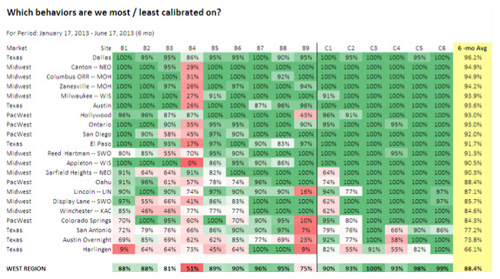A Quality Revolution has been emerging in the last two years, transforming underleveraged and underperforming Quality & Call Monitoring Programs into predictors and drivers of performance improvement. The centerpiece of the revolution is Strategic Quality Assurance (sQA), and it works because it blends equal parts art and science.
This series of articles focused on The Quality Revolution is walking through each of the 5 keys to sQA.
This article is focused on Key #3: Automate Calibration, which lends scale and rigor to the old labor-intensive calibration process of Conventional Quality Programs.
The Problem: Labor-Intensive Calibration Meetings that Lead to… an Uncalibrated Staff, Wasted Effort, and Zero Results
In our second article, we talked about the importance of Embracing Subjectivity when you define your behaviors, because capturing the essence of a customer interaction is far more important than capturing the details.
But if we are going to ask Quality staff and Supervisors to score these subjective behaviors, then we have to be well calibrated.
And the problem is that even in conventional Quality programs, effective calibration is hard.
In a typical Call Center, you might see weekly Calibration Meetings in which Quality staff sit around a table and discuss how they would score a call. If it’s a large enterprise with multiple sites, these calibration meetings could involve conference calls with peers from other sites. And in order to calibrate everybody, they take time.
But if they were effective, one could defend them. The problem is that these Calibration Meetings usually result in 1-2 dominant personalities describing how they would score a call. Everybody else follows suit, without really understanding why. But after the meeting has ended, we have no idea if the staff truly became calibrated… or if they simply learned to toe the line.
In nearly every call center I’ve visited, leadership was unable to say what percent of their Quality staff or Supervisors was calibrated.
The irony is this: Everything else in a call center is measured. We all know that you can only manage what you measure. But almost nobody measures calibration effectively. And almost all contact centers waste time in calibration meetings that drive very little calibration.
The Solution: Automate Calibration
The answer is to automate calibration: to leverage technology to reduce the labor-intensive calibration meetings and provide more objective inspection of Quality, while allowing companies to measure, trend and eventually certify on calibration.
The central feature of calibration software – such as Weber Associates’ “QA Calibrate” tool – should be to provide leadership with insights they can use to manage and improve their Strategic Quality Assurance program. For example:
- Trend calibration over time: Trend reports that show site-by-site, team-by-team, individual-by-individual trends can determine if an organization is getting more calibrated over time, or if recent launches (such as new products or new customer experience training) have degraded calibration.
- Certify individuals: Quality staff, Supervisors, Trainers, and other roles should all be certified regularly on their ability to accurately rate a call. By having reporting that drills down to an individual level, we can identify those individuals who aren’t quite “getting it”, and who need additional coaching. (In conventional Quality programs, these individuals can often “hide” by not speaking up in calibration meetings).
- Identify sites that are “out of step” with other sites: In many large enterprises, each site has its own Quality staff. Automating and quantifying calibration allows an organization to objectively spot those sites that are rating calls differently.
- Identify behaviors that are consistently not calibrated: “Heat Map” reporting allows leadership to identify those behaviors that are consistently problematic in calibration. If a behavior is consistently uncalibrated, then perhaps we should improve how we’ve defined or communicated that behavior.

Let’s take one example to see how this reporting allows an organization to identify “hot spots” to manage to: Look at the Heat Map in figure 1. The different sites that make up this contact center channel are down the left, and the behaviors that they are supposed to be calibrated on are across the top.
What do we see? Three extremely important insights:
- Overall, the channel is well-calibrated. We see more green than red, indicating that most sites are well-calibrated on most behaviors.
- But, the last site (the bottom row) seems to be struggling. Perhaps the Quality staff in that site needs targeted training or coaching on how to score these behaviors.
- Behavior 4 (the fourth column) seems to be consistently uncalibrated across most sites. This tells us that perhaps this organization has done a poor job of defining this behavior, communicating it, or training to it. It seems that everybody has a different opinion of how to score Behavior 4.
Now that this organization sees this Heat Map Reporting, they know exactly how well calibrated they are, and they are able to take decisive and targeted action to improve calibration.
This rigor and science is critical to the Quality Revolution. Calibration can be far more effective when it is automated, quantified, and managed, and those are critical ingredients to driving transformative performance improvement.
Automating Calibration of Outsourced Sites
We’ve talked about two of the benefits of automating calibration:
- It reduces the need for labor-intensive calibration meetings
- It provides hard quantification of how well calibrated the organization is
But there’s a third: Calibrating your outsourced sites.
Most organizations that use outsourcers struggle to keep the outsourcers well-calibrated with their internal reps. The options are difficult:
- Should the organization trust the Quality staff that the outsourcer employs? The outsourcer is incented to show high quality scores.
- Should the organization staff more Quality Advisors to monitor outsourced calls? That requires headcount.
- Should the organization hire a third party Quality Monitoring organization? Again, that costs money, and there is no guarantee that that 3rd party Call Monitoring organization will be any more calibrated.
Automating calibration allows an organization to objectively quantify how well calibrated each outsourcer is, compared to their in-house sites.
What’s Next: Join the Quality Revolution by Building out the Rest of Your sQA Program
So now, we’ve investigated the importance of embracing subjectivity in behaviors, correlating and measuring predictiveness, and automating calibration.
But an effective Strategic Quality Assurance program isn’t just about the behaviors and the numbers. It is about the people. The Quality staff who monitor and score calls, the Supervisors who provide coaching and feedback to the Reps, and the Reps who take all of that information and actually interact with your customers. And if those groups don’t all work together, then it will be nearly impossible to move the needle. So be sure to read the next article in our series, Key #4: Foster the Human Connection.
The Quality Revolution
Read the complete series of articles for a roadmap to transforming your Quality Program into Strategic Quality Assurance (sQA), and making it a lever for performance improvement:


